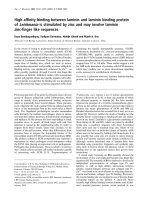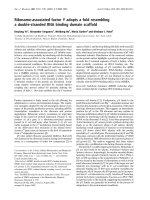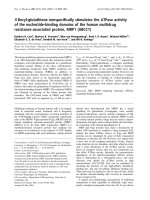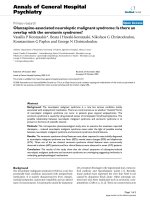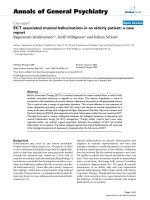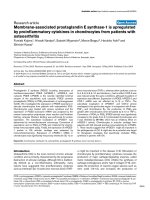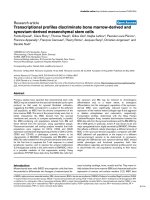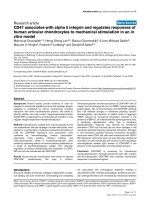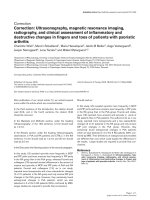Báo cáo y học: "Ventilator associated pneumonia: comparison between quantitative and qualitative cultures of tracheal aspirates" ppsx
Bạn đang xem bản rút gọn của tài liệu. Xem và tải ngay bản đầy đủ của tài liệu tại đây (177.87 KB, 9 trang )
Open Access
Available online />R422
December 2004 Vol 8 No 6
Research
Ventilator associated pneumonia: comparison between
quantitative and qualitative cultures of tracheal aspirates
Luis Fernando Aranha Camargo
1
, Fernando Vinícius De Marco
2
, Carmen Sílvia Valente Barbas
1
,
Cristiane Hoelz
1
, Marco Aurélio Scarpinella Bueno
1
, Milton Rodrigues Jr
1
,
Verônica Moreira Amado
1
, Raquel Caserta
3
, Marinês Dalla Valle Martino
4
, Jacyr Pasternak
4
and
Elias Knobel
5
1
Assistant Physican, Intensive Care Unit, Hospital Israelita Albert Einstein, São Paulo, Brasil
2
Postgraduate Fellow, Intensive Care Unit, Hospital Israelita Albert Einstein, São Paulo, Brasil
3
Respiratory Therapist, Intensive Care Unit, Hospital Israelita Albert Einstein, São Paulo, Brasil
4
Microbiology Laboratory, Intensive Care Unit, Hospital Israelita Albert Einstein, São Paulo, Brasil
5
Head, Intensive Care Unit, Hospital Israelita Albert Einstein, São Paulo, Brasil
Corresponding author: Luis Fernando Aranha Camargo,
Abstract
Introduction Deferred or inappropriate antibiotic treatment in ventilator-associated pneumonia (VAP)
is associated with increased mortality, and clinical and radiological criteria are frequently employed to
establish an early diagnosis. Culture results are used to confirm the clinical diagnosis and to adjust or
sometimes withdraw antibiotic treatment. Tracheal aspirates have been shown to be useful for these
purposes. Nonetheless, little is known about the usefulness of quantitative findings in tracheal
secretions for diagnosing VAP.
Methods To determine the value of quantification of bacterial colonies in tracheal aspirates for
diagnosing VAP, we conducted a prospective follow-up study of 106 intensive care unit patients who
were under ventilatory support. In total, the findings from 219 sequential weekly evaluations for VAP
were examined. Clinical and radiological parameters were recorded and evaluated by three
independent experts; a diagnosis of VAP required the agreement of at least two of the three experts.
At the same time, cultures of tracheal aspirates were analyzed qualitatively and quantitatively (10
5
colony-forming units [cfu]/ml and 10
6
cfu/ml)
Results Quantitative cultures of tracheal aspirates (10
5
cfu/ml and 10
6
cfu/ml) exhibited increased
specificity (48% and 78%, respectively) over qualitative cultures (23%), but decreased sensitivity
(26% and 65%, respectively) as compared with the qualitative findings (81%). Quantification did not
improve the ability to predict a diagnosis of VAP.
Conclusion Quantitative cultures of tracheal aspirates in selected critically ill patients have decreased
sensitivity when compared with qualitative results, and they should not replace the latter to confirm a
clinical diagnosis of VAP or to adjust antimicrobial therapy.
Keywords: bacterial pneumonia, qualitative evaluation, quantitative evaluation, tracheal aspirates, ventilator-associ-
ated pneumonia
Received: 28 April 2004
Revisions requested: 23 June 2004
Revisions received: 19 August 2004
Accepted: 2 September 2004
Published: 14 October 2004
Critical Care 2004, 8:R422-R430 (DOI 10.1186/cc2965)
This article is online at: />© 2004 Camargo et al., licensee BioMed Central Ltd.
This is an Open Access article distributed under the terms of the
Creative Commons Attribution License ( />licenses/by/2.0), which permits unrestricted use, distribution, and
reproduction in any medium, provided the original work is cited.
BAL = bronchoalveolar lavage; cfu = colony-forming unit; ICU = intensive care unit; PSB = protected specimen brush; VAP = ventilator-associated
pneumonia.
Critical Care December 2004 Vol 8 No 6 Camargo et al.
R423
Introduction
The incidence of nosocomial pneumonia in mechanically ven-
tilated patients ranges from 9% to 68%, and mortality rates
range from 33% to 71% [1,2]. In the EPIC (European Preva-
lence of Infection in the Intensive Care) study [3], ventilator-
associated pneumonia (VAP) was the most frequent infection
acquired in the intensive care unit (ICU), accounting for 45%
of all infections in European ICUs.
The diagnosis of VAP is a challenge for the clinician because
the presentation is variable, and other causes of fever and
chest infiltrates may occur in these patients. Clinical/radiolog-
ical evaluations provide the only criteria that permit timely diag-
nosis. Early institution of adequate antibiotic therapy is
associated with decreased mortality, at least in the more
severely ill patients. Culture results are currently used to guide
adjustment or withdrawal of antibiotic therapy rather than to
decide whether to treat. The practice of changing therapy with
culture results has resulted in reduced consumption of antibi-
otics. Conversely, studies have shown that over-treatment with
antibiotics may select organisms such as Pseudomonas aeru-
ginosa and Acinetobacter calcoaceticus [4,5].
The value of endotracheal aspirates for diagnosing VAP is
controversial, but there is a growing body of evidence showing
an important role for these cultures. Recent studies have con-
sistently shown that outcome in VAP may not be influenced by
whether cultures are obtained by bronchoscopy or from tra-
cheal aspirates collected at the bedside. Furthermore, a cost-
effectiveness analysis [6] strongly supported the employment
of tracheal aspirates in the management of VAP.
Although the use of tracheal aspirates in VAP management is
increasing, there are few data regarding the usefulness of
quantitative as opposed to qualitative cultures. Some studies
[7,8] suggested that quantitative cultures should be used in
order to avoid false-positive results, but little is known about
the sensitivity and specificity of quantitative culture findings in
severely ill patients who have previously received broad-spec-
trum antibiotics.
We conducted a prospective follow up of severely ill patients
in a general ICU with a high rate of antibiotic use in order to
evaluate the value of quantification of bacterial colonies in tra-
cheal aspirates for diagnosing VAP.
Methods
Study protocol
This study was conducted between March 2000 and January
2001 in a 28 adult bed medical/surgical critical care unit at the
Hospital Israelita Albert Einstein – a major referral tertiary care
centre. The ethics committee of our institution granted
approval for this investigation.
During the study period, every Monday morning all patients
under mechanical ventilation for at least 48 hours were exam-
ined to determine whether they had VAP by three well trained
intensivists and a respiratory therapist. We chose to evaluate
all ventilated patients irrespective of the presence of VAP
because on Mondays we routinely perform surveillance cul-
tures of tracheal aspirates (in a search for multidrug-resistant
pathogens and to determine contact precautions for such sit-
uations). We also aimed to include both patients with and
without VAP based on clinical and radiological criteria.
The diagnosis of VAP was confirmed if there was agreement
between two of the three physicians using clinical/radiological
criteria. On the same day, the respiratory therapist also pro-
vided a description of the appearance (purulence) of the tra-
cheal secretions. Endotracheal secretions were collected
using a standard procedure and endotracheal aspirates sam-
ples were sent for qualitative and quantitative culture. The
research team was blind to culture results, but the physicians
were aware of the patients' antibiotic consumption when they
were evaluated.
Clinical characteristics were recorded at every evaluation (not
just at enrolment in the study).
Diagnosis of ventilator-associated pneumonia
For the purposes of the present study, VAP was diagnosed
when a patient on mechanical ventilation for at least 48 hours
developed a new or progressive pulmonary infiltrate on the
chest radiograph in association with at least two of the follow-
ing findings: râles or dullness to percussion on chest examina-
tion; new onset of purulent sputum or change in sputum
character; decrease of at least 10% in arterial oxygen tension/
fractional inspired oxygen ratio; leucocytes in excess of
12,000/mm
3
or under 4000/mm
3
; positive blood cultures or
pleural effusion cultures; and axilar temperature greater than
37.8°C or under 36.0°C in the absence of antipyretic treat-
ment (excluding another site of infection).
Tracheobronchial aspirate samples and
microbiological processing
Tracheobronchial secretions were collected by the respiratory
therapist, following specimen collection guidelines, after tra-
cheal instillation of 5 ml saline. The specimens were sent to the
laboratory and cultivated within 1 hour of collection. A dilution
of the tracheal aspirate was prepared and inoculated with a
calibrated loop on chocolate agar and MacConkey agar. After
overnight incubation in appropriate conditions, the plates were
interpreted according to quantification of growth [9,10]. Qual-
itative cultures were considered positive when the growth of
any micro-organism occurred and quantitative cultures were
considered positive when the growth of 10
5
colony-forming
units (cfu)/ml or more was observed. Sensitivity, specificity,
positive predictive value and negative predictive values for
qualitative and quantitative (10
5
cfu/ml and 10
6
cfu/ml)
Available online />R424
cultures from tracheal aspirates were calculated according to
standard formulae. All samples were collected on the day of
clinical and radiological evaluation.
Results
A total of 106 patients were prospectively evaluated during
the study period. The mean age (± standard error) was 66.6 ±
18.3 years. A total of 88 patients (83.0%) were male and 18
(17.0%) were female. The mean Acute Physiology and
Chronic Health Evaluation II score was 20.1 ± 6.5. Medical
patients constituted the majority (60.38%) compared with sur-
gical patients (39.62%; Table 1). Among medical patients, 30
(28.2%) were neurological and 21 (19.8%) were cancer
patients.
In these 106 patients, a total of 314 clinical evaluations were
conducted and endothracheal aspirates collected, corre-
sponding to 42.3 ± 36.5 days (mean ± standard error) of
mechanical ventilation. In 95 of these evaluations the radiolog-
ical or laboratory investigations for VAP were incomplete at the
time of clinical evaluation, and so these evaluations were
excluded. Therefore, a total of 219 evaluations in 106 patients
were included in the analysis.
Thirty-eight (17.4%) evaluations were classified as 'with VAP'
in 33 patients and 181 (82.6%) were classified as 'without
VAP' in 73 patients (Table 2). The overall concordance
between the first two observers for a diagnosis of VAP in the
total population was high (94%). Within the VAP group, the
overall concordance between the first two observers was
86.9%.
Qualitative and quantitative analyses
For qualitative analysis, among all 219 evaluations, 168
(76.7%) yielded cultures that were positive for at least one
agent. In the VAP group, 31 of the 38 evaluations yielded pos-
itive cultures (81.6%). Thus, the sensitivity of qualitative cul-
tures of tracheal aspirates was 81% and the specificity was
23%. The likelihood ratio for a positive test was 1.05 and the
likelihood ratio for a negative one was 0.83. The positive pre-
dictive value was 18% and the negative predictive value was
86%.
For quantitative analysis, among the 219 evaluations, 117 had
≥ 10
5
cfu/ml in tracheal secretions (53.4%) and 49 had ≥ 10
6
cfu/ml (22.4%). In the VAP group, 25 of the 38 evaluations
had ≥ 10
5
cfu/ml (65.8%) and 10 of them had ≥ 10
6
cfu/ml
(26.3%). Thus, for 10
5
cfu/ml the sensitivity was 65% and the
specificity was 48%. The likelihood ratio of a positive test was
1.25 and the likelihood ratio of a negative test was 0.73. The
positive predictive value was 21% and the negative predictive
value was 87%. For 10
6
cfu/ml the sensitivity was 26% and
the specificity was 78%. The likelihood ratio of a positive test
was 1.18 and the likelihood ratio of a negative test was 0.95.
The positive predictive value was 20% and the negative pre-
dictive value was 83% (Table 3).
In the VAP group leucocytosis was present in 26 evaluations
(68.4%) and fever in 24 (63.1%), and purulent endotracheal
secretions were observed by the therapist in 22 (57.8%) eval-
uations. In four evaluations only (10.5%) was blood culture
positive for the same agent as was isolated in endotracheal
secretions (Table 4).
Overall, in 96.8% of evaluations patients were receiving at
least one antibiotic. Prescription of antibiotics for three or
more days before data collection was high (86.7%). The most
frequently administered antibiotics were glycopeptides
(49.7%), antifungals (42.4%), third-generation cepha-
losporins (39.2%), or carbapenem (34.2%; Table 5).
Considering all VAP episodes, the most frequently isolated
agents were Staphylococcus aureus (15.7%), P. aeruginosa
(15.7%) and Acinetobacter baumanii (7.3%). Fungi
Table 1
Demographic data of the patients investigated
Parameter Value
Number of patients 106
Age (years) 66.6 ± 18.3
Ratio of males to females (n) 88/18
APACHE II score 20.1 ± 6.5
Clinical category (n [%])
Medical 64 (60.3%)
Cancer 21 (19.8%)
Neurological 30 (28.2%)
Surgical 42 (39.7%)
APACHE, Acute Physiology and Chronic Health Evaluation.
Critical Care December 2004 Vol 8 No 6 Camargo et al.
R425
accounted for 13.3% of all agents isolated. In 18.4% of eval-
uations in the VAP group, no agent was recovered from the
endotracheal aspirates (Table 6).
Clinical observations
Considering the population as a whole, in 59 evaluations
(26.9%) patients had a tracheostomy. Stress ulcer prophylaxis
was present at 210 of the 219 evaluations (96%), with H
2
-
receptor blockers in 58.4%, proton pump inhibitors in 36.5%
and sucralfate in 0.9%. Sepsis was diagnosed in 46 (21%)
evaluations.
Among the 38 evaluations classified as positive for VAP, tra-
cheostomy was present in ten (26.3%). Previous lung disease
was observed in six (15.7%) events. Ulcer prophylaxis was
present in 100% of evaluations, with H
2
-receptor blockers in
22 (57.8%) and proton pump inhibitors in 16 (42.2%). Sepsis
was diagnosed in 14 (36.8%) evaluations.
Other clinical characteristics are listed in Table 2. A total of 31
(29.2%) patients died during their hospitalization: 11 (33.3%)
of the 33 patients in the VAP group and 20 (27.3%) of the 73
patients without VAP (not significant).
Table 2
Clinical characteristics of the patients in the events investigated.
Parameter Total evaluations (%) Evaluations in VAP group (%)
Number of evaluations 219 (100%) 38 (100%)
Tracheostomy (n [%]) 59 (26.9%) 10 (26.3%)
Atelectasis
a
(n [%]) 13 (6.0%) 6 (15.7%)
Lung edema
a
(n [%]) 35 (16.0%) 9 (23.6%)
Lung contusion
a
(n [%]) 6 (2.7%) 1 (2.6%)
Pleural effusion
a
(n [%]) 21 (9,5%) 8 (21.0%)
Previous lung disease (n [%]) 30 (13.6%) 6 (15.7%)
COPD 16 (7.3%) 3 (7.8%)
Cancer 11 (5.0%) 2 (5.2%)
Asthma 2 (0.9%) 1 (2.6%)
Pulmonary fibrosis 1 (0.4%) None
Broncoaspiration (n [%]) 12 (5.4%) 3 (7.8%)
Sepsis (n [%]) 46 (21.0%) 14 (36.8%)
ARDS (n [%]) 12 (5,4%) 3 (7.8%)
Renal failure (n [%]; creatinine >2.0 mg/dl) 91 (41.5%) 20 (52.6%)
Diabetes (n [%]) 35 (16.0%) 5 (13.1%)
Chemotherapy (n [%]) 13 (6.0%) 2 (5.2%)
Radiotherapy (n [%]) 2 (0.9%) None
Immunossupressants drugs (n [%]) 5 (2.2%) 1 (2.6%)
AIDS (n [%]) 3 (1.3%) None
Renal transplantation (n [%]) 5 (2.2%) 1 (2.6%)
Abdominal surgery (n [%]) 32 (14.6%) 7 (18.4%)
Multiple trauma (n [%]) 21 (9.5%) 3 (7.9%)
Neuromuscular blocking agents (n [%]) 7 (3.1%) 7 (18.4%)
Central venous line (n [%]) 215 (98.0%) 38 (100%)
Intracranial pressure monitoring (n [%]) 20 (9.1%) 1 (2.6%)
a
According to clinical judgement. ARDS, acute respiratory distress syndrome; COPD, chronic obstructive pulmonary disease; VAP, ventilator-
associated pneumonia.
Available online />R426
Discussion
VAP is the most frequent type of infection in ICU patients in
Europe and Latin America (almost half of all nosocomial infec-
tions) [3] and ranks second in US ICUs [11]. The attributable
mortality is higher in medical than in surgical patients, and
rates vary according to the case mix and aetiological agent
[12].
Inadequate or delayed antimicrobial treatment in VAP is an
established independent predictor of death [13]. According to
published data, changing an initial empirical treatment based
on subsequent culture results may have either a beneficial
effect (in terms of mortality, less antibiotic use, less days on
antibiotics) [14] or no effect in more severely ill patients [15].
For this reason, efforts must be directed at choosing adequate
empirical treatment as early as possible, which may be accom-
plished with a high degree of suspicion and adequate guide-
lines based on local antibacterial susceptibilities. In addition,
adhering to ideal pharmacological principles (choosing contin-
uous as opposed to intermittent administration, adjustment for
renal and hepatic failures), reducing dosages when appropri-
ate, and shortening the duration of treatment are presently
standard of care for VAP.
In order to avoid any delay in instituting antibiotic treatment,
reliable diagnostic methods should be employed. Despite their
variable sensitivity and specificity [16], clinical/radiological
findings may currently be considered the best option, although
rapid tests, such as the percentage of infected leucocytes on
bronchial specimens, are promising in that they can provide
rapid confirmation [17]. Culture results for bronchial or tra-
cheal samples may be available late in the course of an epi-
sode of VAP and should not be used to decide whether to
treat, especially in patients who are severely ill. On the other
hand, culture results should be used to adjust (narrow or
extend antibiotic spectrum) or withdraw empirical treatment –
a practice that has been shown to be beneficial, with no
increase in mortality, and that directs medical staff to seek
other unsuspected foci of infection [18].
Although bronchoscopic samples increase the degree of con-
fidence that a diagnosis of VAP is correct [14], endotracheal
aspirates, despite their lack of consistency as a diagnostic tool
Table 3
Qualitative and quantitative analysis
Parameter Qualitative Quantitative
10
5
cfu/ml 10
6
cfu/ml
Sensitivity 81% 65% 26%
Specificity 23% 48% 78%
Positive predictive value 18% 21% 20%
Negative predictive value 86% 87% 83%
Likelihood ratio of positive test 1.05 1.25 1.18
Likelihood ratio of negative test 0.83 0.73 0.95
cfu, colony-forming units.
Table 4
Diagnostic criteria for ventilator-associated pneumonia in order of occurrence
Diagnostic criteria n (%)
Leukocytosis 26 (68.4%)
Fever 24 (63.1%)
Purulent tracheal secretion 22 (57.8%)
Decrease of at least 10% in PaO
2
/FiO
2
ratio 16 (42.1%)
Rales or dullness to percussion on chest examination 9 (23.6%)
Leucopenia 4 (10.5%)
Blood positive cultures 4 (10.5%)
Hypothermia 2 (5.2%)
FiO
2
, fractional inspired oxygen; PaO
2
, arterial oxygen tension.
Critical Care December 2004 Vol 8 No 6 Camargo et al.
R427
[19], are widely employed in the management of VAP. Recent
small trials have consistently shown that there is no advantage
of using bronchoscopic methods over relying on tracheal aspi-
rate cultures when mortality is an end-point [6,20,21].
Reduced costs and similar outcomes were reported using
either quantitative or qualitative tracheal aspirates for guiding
or deciding to interrupt antibiotic treatment for VAP [6]. This
may be due to the high correlation between tracheal aspirates
(both quantitative and qualitative) and bronchoscopic cultures
when presence of VAP is highly probable [21,22]. However,
the above-mentioned studies did not determine the value of
quantification of micro-organisms in tracheal aspirate samples
as compared with qualitative assessment.
Quantification of micro-organisms in biological samples for the
purpose of diagnosing infectious conditions is widely used,
particularly for nosocomial infections. Regarding respiratory
infections, bronchoscopic samples have established cutoff
values (10
4
cfu/ml for bronchoalveolar lavage [BAL] fluid and
10
3
cfu/ml for protected brush specimen [PBS]) for improving
diagnostic performance. On the other hand, use of these cut-
off values has yielded conflicting results, and previous antibi-
otic treatment has great impact on these values. Souweine
and coworkers [23] showed that the standard cutoff values of
BAL and PSB would have to be lowered to 10
3
cfu/ml and 10
2
cfu/ml to retain diagnostic accuracy where antibiotics were
previously administered, mainly when they are given in the pre-
ceding 24 hours.
Only a small number of studies have evaluated the role of
quantitative endotracheal cultures in the diagnosis of VAP.
Albert and coworkers [24], studying 20 ventilated patients and
using clinical/radiological parameters, found the threshold of
10
5
cfu/ml to have a sensitivity of 81%, specificity of 65%,
positive predictive value of 55% and negative predictive value
of 55%. In that study different cutoff values were not tested to
Table 5
Prescription of antimicrobials in all the events studied
Class of antimicrobial Evaluations (n [%])
Glycopeptide 109 (49.7%)
Antifungical 93 (42.4%)
Third generation cephalosporin 86 (39.2%)
Carbapenem 75 (34.2%)
Clindamicin 34 (15.5%)
Quinolone 31 (14.1%)
Metronidazol 26 (11.8%)
Fourth generation cephalosporin 23 (10.5%)
Macrolides 23 (10.5%)
Total 212 (96.8%)
Table 6
Infectious agents isolated in the evaluations of patients with ventilator-associated pneumonia
Aetiological agents Evaluations (n [%])
Gram-negative bacteria 15 (39.4%)
Gram-positive bacteria 11 (28.9%)
Negative cultures 7 (18.4%)
One or more agents 6 (15.7%)
Fungus 5 (13.3%)
Isolated agents
Staphylococcus aureus 6 (15.7%)
Pseudomonas aeruginosa 6 (15.7%)
Acinetobacter baumanii 3 (7.8%)
Available online />R428
evaluate the real usefulness of quantification. Jourdain and
coworkers [25] studied a group of 57 patients with presumed
VAP, 19 (33%) of whom were confirmed by PSB sample with
more than 10
3
cfu/ml. Using quantification in this population,
those investigators showed that the sensitivity of the test
reduced considerably from 86% to 43% whereas specificity
increased from 52% to 95% when a cutoff of 10
3
cfu/ml was
compared with one of 10
7
cfu/ml. No data regarding previous
use of antibiotics were available to explain the decreased
sensitivity.
We conducted a prospective follow up of severely ill patients
with a high rate of antimicrobial use prior to diagnosis of VAP.
Not surprisingly, the most frequent agents recovered were
multidrug-resistant agents, such as methicillin-resistant S.
aureus, P. aeruginosa and Acinetobacter spp.
We found different levels of sensitivity (81%, 65%, 26%) and
specificity (23%, 48%, 78%) for qualitative and quantitative
(cutoffs 10
5
cfu/ml and 10
6
cfu/ml) findings, respectively, as
was expected. However, the positive (18%, 21%, 20%) and
negative (86%, 87%, 83%) predictive values obtained were
very similar.
Our data reveal sensitivity values for tracheal aspirates similar
to those observed in the above-mentioned studies, although
specificity values were lower. According to our data, use of the
cutoff value 10
5
cfu/ml reduced the sensitivity of the test to lev-
els too low to be useful in clinical practice, bearing in mind the
proposed role of tracheal aspirates to guide antibiotic with-
drawal or modification. Moreover, quantification did not
improve predictive values for the purposes of diagnosing VAP
at the time when a suspected case was evaluated.
Patient characteristics may have an impact on the accuracy of
diagnostic tests. Although there is broad correlation between
the number of bacterial colonies in biological samples and the
occurrence of infection as opposed to colonization, the exact
bacterial count cannot be predicted in highly ill patients, for
whom a lower inoculum may be sufficient for disease develop-
ment. This has been observed for catheter-related infections in
severely ill patients in a surgical ICU [26], in which true cathe-
ter-related bacteraemia was reported with fewer than 15 cfu
on catheter tips. In our patient population there was a signifi-
cant proportion of patients with renal failure, diabetes, cancer
and sepsis – conditions that are known to be associated with
immunosuppression.
These decreased sensitivity values may also be explained by
antimicrobial use. More than 95% of the patients studied were
receiving antibiotics when the sample was collected for analy-
sis, and the majority of them were broad-spectrum antibiotics
(almost 50% had received glycopeptides and 35% carbapen-
ems). About 80% had received them for longer than 72 hours.
Decreased accuracy of quantification with samples obtained
by bronchoscopy was reported by Soweine and coworkers
[23]. BAL and PSB had significantly less sensitivity when the
procedure was performed within 24 hours of antibiotic use
than when antibiotics had not been given for longer than 72
hours. The impact of antibiotic use may be greater for tracheal
aspirates, irrespective of the timing of administration; this may
be due to the higher concentration of the antibiotic in upper
tract secretions, although this point requires further
investigation.
Our study has a number of limitations. While we attempted to
achieve a high degree of certainty in clinical/radiological
parameters, with the participation of three experienced ICU
physicians (with a high degree of correlation between them),
no 'gold standard' technique was employed, such as broncho-
scopic samples (although it remains controversial whether
bronchoscopy samples can be regarded as the gold standard
for VAP). Because of the low specificity of clinical judgement,
we must consider the fact that we are studying a population in
which VAP rate is over-estimated. This is supported by the rate
of 18.4% of VAP diagnoses with a negative tracheal aspirate
finding and a 13.3% rate of fungal isolates, which only rarely
can be considered true causative agents. Thus, it is possible
that we have false-positive rate of at least 31.7%, although
technical problems with specimen collection cannot be ruled
out. The virtual absence of a gold standard for VAP makes
study designs that address the issue of diagnostic tests diffi-
cult. In accordance with our study design, we evaluated all
patients with mechanical ventilation every week, irrespective of
clinical suspicion of VAP. This strategy may have beneficial
effects because we included in the same population patients
who were likely and those who were unlikely to have definite
VAP, but increasing the possibility of false-positive cases.
Other study designs use populations selected because clini-
cal/radiological judgement suggest the presence of VAP. In
these studies, the control cases (no VAP) are defined as hav-
ing negative bronchoscopic cultures, based on predetermined
cutoff values. In these situations, problems with the lesser sen-
sitivity of bronchoscopic samples in patients on antibiotics,
and even the intrinsically low sensitivity of this diagnostic strat-
egy when compared with histological criteria [27], increase
the likelihood of including false-negative control individuals. In
other words, with our study design we might have
overestimated VAP, as compared with underestimating it with
conventional study designs. For this reason we think that there
is no ideal design for such studies, and studies that rely solely
upon clinical/radiological parameters should not systemati-
cally be discarded. Furthermore, the use of bronchoscopy in
our hospital is unreliable, as it may be in a large number of gen-
eral ICUs.
Tracheal aspirates have a definite role to play in the manage-
ment of VAP, but only when correlated with clinical findings
[28]. The use of quantitative results may be associated with
Critical Care December 2004 Vol 8 No 6 Camargo et al.
R429
under-diagnosis of VAP, leading to inappropriate changes to
antibiotic regimens and, in some cases, antibiotic delay or
withdrawal.
Conclusion
The severely ill and those who have previously received
courses of broad-spectrum antibiotics – a population whose
number is expected to increase in modern ICUs – may be tar-
geted for use of qualitative findings rather than quantitative
cultures of tracheal secretions for VAP management.
Quantitative results may add costs and workload (in our labo-
ratory it is five times more time consuming) and may then be of
limited value in this group of patients, although enhanced spe-
cificity may be beneficial in terms of avoiding unnecessary
treatment. In selected groups of severely ill patients, quantita-
tive cultures of tracheal aspirates should not replace qualita-
tive cultures for confirmation of diagnosis or management of
antibiotic therapy.
Competing interests
The authors declare that they have no competing interests.
References
1. Bowton DL: Nosocomial pneumonia in the ICU: year 2000 and
beyond. Chest 1999, 115 (3 suppl):S28-S33.
2. Fagon JY, Chastre J, Vuagnat A, Trouillet JL, Novara A, Gibert C:
Nosocomial pneumonia and mortality among patients in inten-
sive care units. JAMA 1996, 275:866-869.
3. Vincent JL, Bihari DJ, Suter PM, Bruining HÁ, White J, Nicolas-
Chanoin MH, Wolff M, Spencer RC, Hemmer M: The prevalence
of nosocomial infection in intensive care units in Europe.
Results of the European Prevalence of Infection in Intensive
Care (EPIC) study. JAMA 1995, 274:639-644.
4. Celis R, Torres A, Gatell JM, Almela M, Rodriguez-Roisin R: Noso-
comial pneumonia: a multivariate analysis of risk and
prognosis. Chest 1988, 93:318-324.
5. Rello J, Ausina V, Ricart M: Risk factors for infection by Pseu-
domonas aeruginosa in patients with ventilator-associated
pneumonia. Intensive Care Med 1994, 20:193-198.
6. Ruiz M, Torres A, Ewig S, Marcos MA, Alcón A, Lledó R, Asejo MA,
Maldonado M: Non-invasive versus invasive microbial investi-
gation in ventilator associated pneumonia: evaluation of
outcome. Am J Respir Crit Care Med 2000, 162:119-125.
7. Ioanas A, Ferrer R, Angrill J, Ferrer M, Torres : A microbial inves-
tigation in ventilator-associated pneumonia. Eur Respir J 2001,
17:791-801.
8. Salata RA, Lederman MM, Shales DM: Diagnosis of nosocomial
pneumonia in intubated, intensive care unit patients. Am Rev
Respir Dis 1987, 135:426-432.
9. Shea YR: Specimen collection and transport. In Clinical Micro-
biology Procedures Handbook Edited by: Isenberg HD. Washing-
ton, DC: ASM Press; 1997. section 1.1.1.
10. James L, Hoppe-Bauer JE: Processing and interpretation of
lower respiratory tract specimens. In Clinical Microbiology Pro-
cedures Handbook Edited by: Isenberg HD. Washington, DC:
ASM Press; 1997. section 1.15.1.
11. Richards MJ, Edwards JR, Culver DH, Gaynes RP: Nosocomial
infections in medical intensive care units in the United States.
National Nosocomial Infections Surveillance System. Crit Care
Med 1999, 27:887-892.
12. Heyland DK, Cook DJ, Griffith L, Keenan SP, Brun-Buisson C: The
attributable morbidity and mortality of ventilator-associated
pneumonia in the critically ill patient. The Canadian Critical Tri-
als Group. Am J Respir Crit Care Med 1999, 159:1249-1256.
13. Kollef MH, Ward S: The influence of mini-BAL cultures on
patient outcomes: implications for the antibiotic management
of ventilator-associated pneumonia. Chest 1998, 113:412-420.
14. Heyland DK, Cook DJ, Marshall J, Heule M, Guslits B, Lang J, Jae-
schke R: The clinical utility of invasive diagnostic techniques in
the setting of ventilator-associated pneumonia. The Canadian
Critical Care Trials Group. Chest 1999, 115:916-917.
15. Luna CM, Vujacich P, Niederman MS, Vay C, Gherardi C, Matera
C: Impact of BAL data on the therapy and outcome of ventila-
tor-associated pneumonia. Chest 1997, 111:676-685.
16. Lefcoe MS, Fox GA, Leasa DJ, Sparrow RK, McCormack DG:
Accuracy of portable chest radiography in the critical care set-
ting. Diagnosis of pneumonia based on quantitative cultures
obtained from protected brush catheter. Chest 1994,
105:885-887.
17. Allaouchiche B, Jaumain H, Dumontet C, Motin J: Early diagnosis
of ventilator-associated pneumonia. Is it possible to define a
cutoff value of infected cells in BAL fluid? Chest 1996,
110:1558-1565.
18. Fagon JY, Chastre J, Wolff M, Gervais C, Parer-Aubas S, Stéphan
F, Similowski T, Alain Mercat, Diehl JL, Sollet JP, Tenaillon A: Inva-
sive and noninvasive strategies for management of suspected
ventilator-associated pneumonia. A randomized trial. Ann
Intern Med 2000, 132:621-630.
19. Cook D, Mandell L: Endotracheal aspiration in the diagnosis of
ventilator-associated pneumonia. Chest 2000, 117(4 Suppl
2):195S-197S.
20. Sole-Violan J, Fernandez JA, Benitez AB, Cendrero JAC, Castro
FR: Impact of quantitative invasive diagnostic techniques in
the management of outcome of mechanically ventilated
patients with suspected pneumonia. Crit Care Med 2000,
28:2737-2741.
21. Sanchez-Nieto JM, Torres A, Cordoba FG, El-Ebiary M, Carrillo A,
Ruiz J, Nunez ML, Niederman M: Impact of invasive and noninva-
sive quantitative culture sampling on outcome of ventilator-
associated pneumonia: a pilot study. Am J Respir Crit Care
Med 1998, 157:371-376.
22. Rumbak MJ, Bass RL: Tracheal aspirate correlates with pro-
tected specimen brush in long-term ventilated patients who
have clinical pneumonia. Chest 1995, 106:531-534.
23. Souweine B, Veber B, Bedos JP, Gachot B, Dombret MC, Regnier
B, Wolff M: Diagnostic accuracy of protected speciemen brush
and bronchoalveolar lavage in nosocomial pneumonia: impact
of previous antimicrobial treatments. Crit Care Med 1998,
26:198-199.
24. Albert S, Kirchner J, Thomas H, Behne M, Schur J, Brade V: Role
of quantitative cultures and microscopic examinations of
endotracheal aspirates in the diagnosis of pulmonary infec-
tions in ventilated patients. J Hosp Infect 1997, 37:25-37.
25. Jourdain B, Novara A, Joly-Guillou ML, Dombret MC, Calvat S,
Trouillet JL, Chastre JG: Role of quantitative cultures of endotra-
cheal aspirates in the diagnosis of nosocomial pneumonia.
Am J Respir Crit Care Med 1995, 152:241-246.
26. Charalambous C, Swoboda SM, Dick J, Perl T, Lipsett PA: Risk
factors and clinical impact of central line infections in the sur-
gical intensive care unit. Arch Surg 1998, 133:1241-1246.
Key messages
• Quantitative cultures of tracheal aspirates have
increased specificity compared with qualitative analy-
sis for diagnosis of VAP.
• The sensitivity values for quantitative cultures of tra-
cheal aspirates are significantly lower than those for
qualitative cultures for VAP diagnosis in severely ill
patients receiving prior antibiotics.
• Quantitative cultures of tracheal aspirates should not
replace qualitative cultures for the purpose of confirm-
ing a clinical diagnosis of VAP or adjusting antimicro-
bial therapy.
Available online />R430
27. Torres A, Fàbregas N, Ewig S, Bellacasa JP, Bauer TT, Ramirez J:
Sampling methods for ventilator associated pneumonia: vali-
dation using different histologic and microbiological
references. Crit Care Med 2000, 28:2799-2804.
28. Grossman RF, Flein A: Evidence-based assessment of diag-
nostic tests for ventilator-associated pneumonia. Chest 2000,
117(4 Suppl 2):177S-181S.
